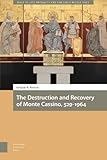The Destruction and Recovery of Monte Cassino, 529-1964 / Kriston R. Rennie.
Material type: TextSeries: Italy in Late Antiquity and the Early Middle Ages ; 1Publisher: Amsterdam : Amsterdam University Press, [2021]Copyright date: ©2021Description: 1 online resource (246 p.)Content type:
TextSeries: Italy in Late Antiquity and the Early Middle Ages ; 1Publisher: Amsterdam : Amsterdam University Press, [2021]Copyright date: ©2021Description: 1 online resource (246 p.)Content type: - 9789048552122
- Monasticism and religious orders -- History -- Italy -- Cassino Region
- Diachronic
- European history: Reformation
- European history: Renaissance
- European history: medieval period, middle ages
- History, Art History, and Archaeology
- Sociology and Social History
- HISTORY / Europe / Italy
- Monasticism, destruction, heritage, culture, Italy
- 271.1 23
- online - DeGruyter
| Item type | Current library | Call number | URL | Status | Notes | Barcode | |
|---|---|---|---|---|---|---|---|
 eBook
eBook
|
Biblioteca "Angelicum" Pont. Univ. S.Tommaso d'Aquino Nuvola online | online - DeGruyter (Browse shelf(Opens below)) | Online access | Not for loan (Accesso limitato) | Accesso per gli utenti autorizzati / Access for authorized users | (dgr)9789048552122 |
Browsing Biblioteca "Angelicum" Pont. Univ. S.Tommaso d'Aquino shelves, Shelving location: Nuvola online Close shelf browser (Hides shelf browser)

|

|

|

|

|

|

|
||
| online - DeGruyter Food Culture and Literary Imagination in Early Modern Italy : The Renaissance of Taste / | online - DeGruyter The Netherlands and European Integration, 1950 to Present / | online - DeGruyter Religion, Hypermobility and Digital Media in Global Asia : Faith, Flows and Fellowship / | online - DeGruyter The Destruction and Recovery of Monte Cassino, 529-1964 / | online - DeGruyter The Reputation of Edward II, 1305-1697 : A Literary Transformation of History / | online - DeGruyter Titian's Allegory of Marriage : New Approaches / | online - DeGruyter The Guangdong Model and Taxation in China : Formation, Development, and Characteristics of China's Modern Financial System / |
Frontmatter -- Table of Contents -- Acknowledgements -- Abbreviations -- Prologue: The Oak Tree -- Part I Animus and Anchor -- 1. An Enigma: The Legend of Saint Benedict -- 2. The ‘Citadel of Campania’: Growth and Prosperity -- Part II Rise and Fall -- 3. A Destiny Repeated: Episodes of Destruction -- 4. Floreat Semper: Rebuilding, Stone by Stone -- Part III Preservation and Valorisation -- 5. The People’s Patrimony: Defining Historical Value -- 6. A New Europe: Erasing the Destruction -- Epilogue: Lighthouse -- References -- Index
restricted access online access with authorization star
http://purl.org/coar/access_right/c_16ec
Between the sixth and twentieth centuries, the Benedictine Abbey of Monte Cassino (est. 529) experienced a cycle of atrocities which forever transformed its identity. This book examines how such a tumultuous history has been constructed, remembered, and represented from the Middle Ages to the present day. It uses this singular and pivotal case to analyse the historical process of remembering and its impact on modern representations of the past. Exactly how Monte Cassino is remembered is distinctive and diagnostic. The abbey is recognizable today as a beacon of western civilization, culture, and learning precisely because of its 'destruction tradition' over fourteen centuries. This book asks how the abbey's fragmented past has been ideologically, politically, and culturally constituted and preserved; how its experience with destruction and suffering - and recovery and rebirth - has become incorporated into a modern narrative of progress and triumph.
Mode of access: Internet via World Wide Web.
In English.
Description based on online resource; title from PDF title page (publisher's Web site, viewed 01. Dez 2022)


